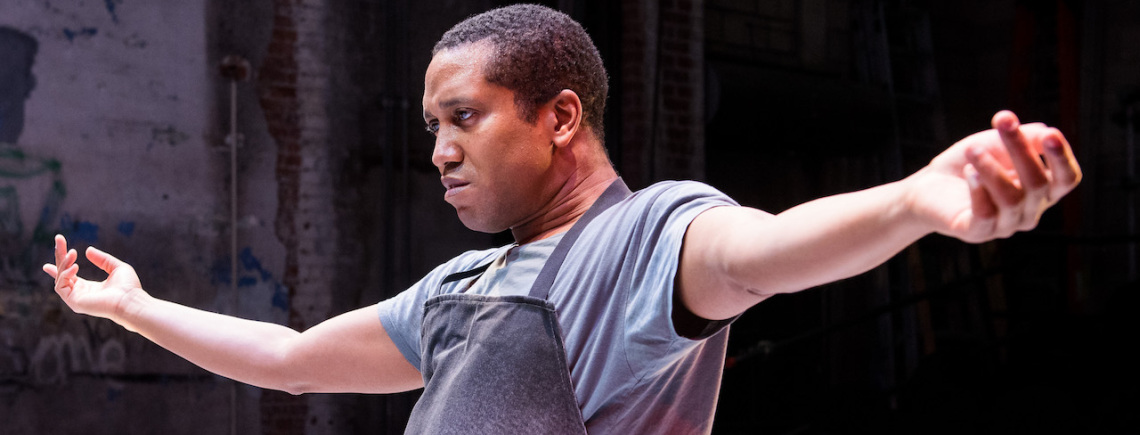Archives

Ligia Lewis
minor matter
Friday June 9, 9:30pm
Saturday June 10, 9:30pm
Run Time: 65 minutes
Hollins University, Theater
Roanoke, Virginia
The second in a trilogy of choreographed works, minor matter draws upon visual and conceptual metaphors of and relating to blackness. Continuing Lewis’s ongoing engagement with affect and embodiment while interrogating the social inscriptions of the body, minor matter poses questions about the black body within the frame of the black box. Built on the logic of interdependence, the theater’s parts—light, sound, image, and architecture—become entangled with the three dancers, giving life to a vibrant social and poetic space. In this work, Lewis turns to the color red to materialize thoughts between love and rage.
minor matter is a production by Ligia Lewis in coproduction with HAU Hebbel am Ufer. Funded by the Governing Mayor of Berlin – Senate Chancellery – Cultural Affairs and Fonds Darstellende Künste e.V. Performances of minor matter for American Realness 2017 are made possible with support the Senate Department for Cultural and Europe and Lumberyard, formerly American Dance Institut/ADI.
Photo by Dorothea Tuch
Concept & Choreography: Ligia Lewis
Performers: Jonathan Gonzalez, Ligia Lewis, Tiran Willemse
Musical Dramaturgy: Michal Libera Styling: Alona Rodeh Lights: Andreas Harder
Dramaturgy: Ariel Efraim Ashbel Assistance: Martha Glenn
Production & Distribution: Nicole Schuchardt / HAU Hebbel am Ufer
minor matter is a production by Ligia Lewis in co-production with HAU Hebbel am Ufer. Funded by the Governing Mayor of Berlin – Senate Chancellery – Cultural Affairs and Fonds Darstellende Künste e.V. Additional support provided by residencies at FD-13, PACT Zollverein, 8:tension/Life Long Burning and collective address.
Ligia Lewis is a dancer and choreographer. She creates affective choreographies while interrogating the metaphors and social inscriptions of the body. Lewis’s work continues to provoke the nuances of embodiment. Her work has been shown at various venues and festivals, such as Abrons Arts Center/American Realness (New York), Flax/Fahrenheit (Los Angeles), Palais de Tokyo (Paris) and Tanz im August (Berlin). Lewis was awarded the Prix Jardin d’Europe for her work “Sorrow Swag.” As a dancer, Lewis has performed and toured extensively with and alongside the following: Eszter Salamon, Mette Ingvartsen, Ariel Efraim Ashbel, Jeremy Wade, Wu Tsang, and Les Bal- letsCdelaB.
Jonathan Gonzalez is an artist working through performance, sound design/composition, writing and visual practices. He has been a Posse and Bessie Schönberg Scholar, Diebold Award recipient for Distinction in Choreography & Performance, Brooklyn Arts Exchange Fellow and New York Live Arts Fresh Tracks Artist. He has collaborated in the works of Patricia Hoffbauer, Cynthia Oliver, Jaamil Kosoko, Isabel Lewis, Jomama Jones, Philip Howze and Grisha Coleman, among others.
Tiran Willemse is a contemporary dancer, born in Western Cape, South-Africa. He studied at English National Ballet school and attend P.A.R.T.S research cycle in Belgium. He performed with Jerome Bel, Eszter Salamon, Andros Zins-Browne, Daniel Linehan and Susane Linke and Deborah Hay.
“The work is elusive, yet poetic,” – Allen Smith, LOST WKND, Published April 2016
“For me, this constraint is a kind of freedom, perhaps the best kind. The intra-action of this inside/outside is what drives my creative engagements. The endless negotiation between those two sites, between thought and flesh, enables a becoming, a liveness captured by embodiment, beyond reason and beyond the limits of representational orders like identity.”
- Ligia Lewis, The Brooklyn Rail, Published July 11th, 2016
“When I first saw Ligia Lewis’s Sorrow Swag at the American Realness festival in New York City in January 2016, I could tell there were deep and complex layers of significance informing the work, a developed vocabulary and particular inner logic. I knew I was not yet fluent in this language, so I went back to see the show a second time. I processed this experience in writing, and was left with many potent questions on expressions of power through the body, language, and theatrical convention.”
– Emily Gastineau, Temporary, Published June 22nd, 2016

HOUSE OF REALNESS
Mx. Oops/Wendell Cooper with STEFA*
& Slim Ninja, Narcissister, Justin
Vivian Bond and Champagne Jerry

Wendell Cooper/Mx. Oops with STEFA* & Slim Ninja
Thursday, May 18, 9:00pm
Friday, May 19, 8:30pm
Saturday, May 20, 8:30pm
Sunday, May 21, 8:30pm
Performeum, Halle 4
Laxenburger Str. 2A, 1100 Wien
Beyond identity there is the plasma of oneness; a dream space, both physical and energetic, that can hold the fullness of we. Carrying Capacity is a speculative journey mixing sacred and profane. It asks; what is the connection between our capacity to love ourselves as simultaneously sexual, spiritual, and social beings with our collective future on this dusty rock?
Mixing elements of vogue, capoeira, urban dance, sound meditation, video projection and rap Mx. Oops/Wendell Cooper performs a multimedia ritual; a dynamic exploration of embodiment to heals the effects of her toxic masculinity. Featuring composer and performer STEFA* and guest choreography and performance by Slim Ninja.
Created and performed by Mx. Oops/Wendell Cooper with STEFA* & Slim Ninja
Wendell Cooper/Mx. Oops is a multimedia performance artist focused on the intersection of urban arts and consciousness studies. A certified yoga instructor (500hr RYT) and practitioner of Thai Yoga Massage, he is also trained in various forms of energy healing. His work has toured Kenya, China, Russia, the Netherlands, various US cities, and has been presented in NYC venues such as American Realness at Abrons Arts Center, HERE Arts Center, Santos Party House, The Box, Dixon Place, Joyce Soho, and Harlem Stage.
Founder of Complex Stability, Cooper creates interdisciplinary work with a focus on the intersection of urban arts and consciousness studies to engage the public in a conversation around how culturally engrained biases creep into our consciousness and interrupt our ability to transcend apparent ‘otherness’.
Cooper performs as Mx. Oops, ‘an ambisexual juggernaut from a sister dimension’. Mx. Oops is a manifestation of Cooper’s training in mediation and healing, using multimedia performance and installation as a tool to explore the role of consciousness in the age of new media.
Cooper has taught and performed as Mx. Oops both nationally and internationally. Urban dance and rapping, as a part of an emerging global language of Hip Hop, have served as a way for him to share ideas and philosophies with artist in many cultures. This sense of urban dance and electronic music being a transcultural space of inclusion and sharing of information is central to his work.
His work has been supported by the Jerome Foundation Travel Study Program, Lower Manhattan Cultural Council, the New York Live Arts Suitcase Fund, and as a Cultural Enjoy of the U.S. State Department in Kenya. Cooper studied dance and religion at the George Washington University and completed an Integrated Media Arts MFA at Hunter College. He currently teaches in Lehman College’s Dance (BA) and Multimedia Performing Arts (BFA) Programs. [www.mxoops.com]
STEFA* is a composer and performer. Drawing inspiration from the intersection of politics, the self and her cultures, she relishes in taking apart language and classical structures juxtaposed with the raw voice. In projecting new narratives, she is taking back her power. Classically trained in both voice and acting, her alma matters include Laguardia Arts (NY) and Royal Central School of Speech and Drama (London, UK). After studying voice for 20 years, she had the opportunity to facilitate ‘Cantos Primitivos//Primal Songs’, a workshop while a resident at TrueQué Artist Residency in Ayampe, Ecuador (2017). Unit52 member with INTAR Theatre. Educator at Museum of the Moving Image + International Center of Photography. Current endeavors include composing a film score for a New York Live Arts funded multi-media video project, ‘La Morena’. Debut EP coming Summer 2017. [www.stefalives.com]
Jason Anthony Rodriguez aka Slim Ninja, native of New York City, quietly grew up within a niche of the vogue community exploring underground dance from a curious distance. Primarily, exposed to the world of dance at Brockport College which sparked the pursuit of a professional career. Furthering his training, he transferred to Purchase College to excel his technique by training with the Conservatory of Dance as an Arts Management major. Jason was invited by Dwight Rhoden to attend the Complexions Contemporary Ballet Summer Intensive. After graduating Purchase College in 2012, he received opportunities to strengthen his technical, teaching and choreographic aesthetics with Kevin Wynn by assisting him in setting pieces and teaching classes.
Jason has been seen assisting Ballet Teacher Dorit Koppel both in class and on media for Broadway Dance Center’s BDC Move. He has also been recently seen on the Netflix series “The Get Down” directed by Baz Luhrmann as a featured voguer.
He has performed with Abraham.In.Motion as a dancer for APAP. Also, he was a part of the pre-production progress of the Off-Broadway show Fortress of Solitude with Camille A Brown and Dancers. He has also performed with Buglisi Dance Theatre in their yearly ritual of The Table of Silence.
Now, he is personal/rehearsal assistant for Kevin Wynn who is faculty at Purchase College and at the Alvin Ailey School. He is a voguer/choreographer for the Iconic House of Ninja and has recently premiered his work “Immersion in Vogue” at Summerstage 2016. Gia Kourlas of The NY Times has recently mentioned his work “a vibrant performance…promising…“Immersion in Vogue,” by Jason Rodriguez or Slim Ninja.”

Champagne Jerry
Thursday, May 18, 9:00pm
Friday, May 19, 8:30pm
Saturday, May 20, 8:30pm
Sunday, May 21, 8:30pm
Performeum, Halle 4
Laxenburger Str. 2A, 1100 Wien
Champagne Jerry is a rap artist with a wild stage show that veers between comedic sexuality and tales of being an East Texas fuck-up. Adam Ad Rock Horovitz of the Beastie Boys remarked “Champagne Jerry records are definitely, in one way, on the very far end of the weird spectrum of rap music, then, in another way, very far on the weird punk spectrum. They meet at these two ends in this bizarre way. People don’t usually meet at the place where Champagne Jerry meets.” Champagme Jerry tells audiences that all of their dreams will come true. Well, not all of them, but one. Maybe two.
Performed by Neal Medlyn
Champagne Jerry, “New York’s finest underground rapper,” was named one of the best performers in New York by Time Out, profiled in Rolling Stone, Brooklyn Vegan and Interview magazine and been a musical guest on The Chris Gethard Show on Fusion TV. He is a music and performance project of Neal Medlyn alongside collaborators Max Tannone, Adam Ad-Rock Horovitz and his onstage entourage of Tannone, Sophia Cleary, Farris Craddock and the Ghost of Champagne Past. Champagne Jerry continues Medlyn’s prior work with pop stars in his Pop Star Series. The aim is to continuously create and provide the most significant moments in everyone’s lives. He has routinely sold out shows at Joe’s Pub in New York City where he had a year long residency and has played the Brooklyn Academy of Music, The Kitchen, New York Live Arts, Union Pool, Pianos, and various rock clubs, parties, Walmart parking lots, art venues and theaters on tour across the U.S. His album and videos for his albums “For Real, You Guys” and “The Champagne Room” are available now everywhere.

Justin Vivian Bond
Thursday, May 18, 9:00pm
Friday, May 19, 8:30pm
Saturday, May 20, 8:30pm
Sunday, May 21, 8:30pm
Performeum, Halle 4
Laxenburger Str. 2A, 1100 Wien
In an attempt to practice radical empathy Mx Justin Vivian Bond is stepping out of their liberal champagne bubble and venturing on a cultural fact finding mission across the world. Sticking with their credo, “Keep it Pretty, Keep, it Shallow, Keep it Moving,” Mx Bond asks, “Why alienate when you can infiltrate?”
Share thoughts, ideas and world views with this trans-genre phenomenon and as they explore what common links we can enjoy with the right social lubricants and musical interludes but never forget, “Glamour is Resistance!”
Performed by Justin Vivian Bond
with..
Matt Ray on piano
Claudia Chopek on violin
Nath Ann Carrera on guitar
Mx. Justin Vivian Bond is a trans-genre artist living in New York City, but in showbiz terms, Bond is a quintuple threat—a celebrated singer/songwriter, author, painter, performance artist and occasional actor. Described as “the best cabaret artist of this generation,” As a performer both on and Off-Broadway, Mx Bond has received numerous accolades winning an Obie (2001), a Bessie (2004), a Tony nomination (2007), the Ethyl Eichelberger Award (2007), The Peter Reed Foundation Grant and a New York Foundation for the Arts Grant for Artists. V authored the Lambda Literary Award winning memoir TANGO: My Childhood, Backwards and in High Heels (The Feminist Press, 2011).

Narcissister
Thursday, May 18, 9:00pm
Friday, May 19, 8:30pm
Saturday, May 20, 8:30pm
Sunday, May 21, 8:30pm
Performeum, Halle 4
Laxenburger Str. 2A, 1100 Wien
Narcissister employs a spectacle-rich approach to explorations of gender, racial identity, and sexuality. Humor, pop songs, elaborate costumes, contemporary dance, and her trademark mask are her tools in deconstructing stereotypical representations. By opening up and turning against themselves what Stuart Hall calls “fixed and closed stereotypical representations,” Narcissister exposes, in live performance, video and photography, the practice of representation itself, and challenges the audience to question its own attraction and repulsion.
Created and performed by Narcissister
Narcissister is a Brooklyn-based artist and performer. Wearing mask and merkin, she works at the intersection of performance, dance, art, and activism. She actively integrates her prior experience as a professional dancer and commercial artist with her art practice in a range of media including photography, video art, and experimental music. She has presented work in New York at The New Museum, Moma PS 1, The Kitchen, and at Abrons Art Center and at many nightclubs, galleries, and alternative art spaces. Narcissister was a re-performer of Marina Abramovic’s Luminosity piece as part of The Artist is Present retrospective at MoMA. Narcissister has also presented her work internationally at the Music Biennale in Zagreb, Croatia, at Chicks on Speed’s Girl Monster Festival, at The City of Women Festival in Ljubljana, Slovenia, at Warehouse 9, Copenhagen’s first live art festival, and at the Camp/Anti-Camp festival in Berlin, among many others. Her art videos have been included in exhibitions and film festivals worldwide, including on MocaTV. Her film The Self-Gratifier won an award for “Best Use of a Sex Toy” at The 2008 Good Vibrations Erotic Film Festival and her film “Vaseline” won the main prize of this festival in 2013. Interested in troubling the divide between popular entertainment and experimental art, Narcissister appeared on America’s Got Talent in 2011. Narcissister was in FORE at The Studio Museum and had her first solo gallery exhibition “Narcissister is You” at envoy enterprises in February 2013. She was nominated for a 2013 Bessie Award for her evening-length piece “Organ Player” which debuted at Abrons Art Center in March 2013. Narcissister is a 2015 Creative Capital Fellow, a 2015 Theo Westernberger Grantee, and a 2015 United States Artists Fellow.

Between Rage and Love
Danielle Jackson on Ni’Ja Whitson/The NWA Project’s A Meditation on Tongues

Between Rage and Love
By Danielle Jackson
Marlon Riggs’ seminal and controversial film Tongues Untied (1989) affirms life at the anxious intersection of dual marginalization experienced by black gay men from straight, black circles and queer, white counterparts. “We are of great value to our community and to ourselves,” said Riggs in an interview.[1] An experimental documentary that is assertive, yearning, declarative, earnest, and tender, Riggs’ film combines heartfelt confessions rendered through poetry, scenes of homophobia pulled from televised media, stagings of vernacular dance, and original verité footage of men in the life. Its ultimate testimony to the immense healing powers of love and care among black gay men was a bold and necessary charge amid the spiraling AIDS crisis of the 1980s and early 90s (Riggs, as well as Essex Hemphill and Joseph Beam–two of the film’s prominent poet-performers–would all die of complications from AIDS-related diseases before turning forty). A reviewer at the New Jersey Star Ledger said the film was “held together with anger and self-pity.”[2] Others found it “obscene,” “annoying,” “grating,” and “obnoxious.” Vocal objections to its depictions of men kissing, “street language,” profanity, and use of racial and homophobic slurs placed Tongues Untied firmly within the culture wars when it aired on public television nationwide in 1991. Since Riggs received a $5,000 grant from the NEA towards its production, conservative media watchdog groups charged the federal government with misappropriation of taxpayers’ funds. Members of the public and a number of legislators mounted pressure to cancel its broadcast, and ultimately, according to scholar B.J. Bullert, only 60 percent of the nation’s viewers had an opportunity to see it.[3] In response to claims that the film breached the community standards established by local networks, Riggs replied, “there’s no one “community” in any community.”
True indeed. Despite the public outcry, the choreographer and dance artist Ni’Ja Whitson recalls that many people “came up and came out” with this film, including cisgender women. Whitson’s live interdisciplinary adaptation, A Meditation on Tongues, is a nonlinear abstraction of this source material. Whereas Tongues Untied examines how a black, gay men exist in multiple communities, Whitson’s performance goes a step further by exploring how masculinity exists in multiple genders. Are black lesbians and gender nonconforming people greeted with suspicion and fear because of their masculinity? How does the spirit of brotherhood transcend “biological” maleness? In this performance, demure gazes and aggressive grunts are loosened and unappointed to any gender. By placing lesbian and gender nonconforming performers (Whitson and collaborator Kirsten Flores-Davis) into narratives originally addressing black gay men, Meditation conjures the liminal space that births self-creation, shifting frequently between rage and love.
During an extended sequence of Mediation, Flores-Davis writhes on the floor in a clearing between audience members, their body alternating between hoarse spasms and rigor mortis, choking, gasping for air, clawing at the mouth, as though suffocating from internal and external pressures. The movements may recall the shameful demise of Eric Garner and the many specters of black death in recent years, but I am also reminded of a map on the windowpanes above the theater that marks, among other miscarriages of justice, the murders of trans people by bigots across the nation. I know trans folks who resent these injustices that go unrecognized. What does lack of recognition do to a person? Unifying tragic losses in queer communities–which have gone largely unnoticed by mainstream media–with highly-visible murders of cisgender black men, is a powerful gesture here. But the sequence may also refer to something else. Some of the scornful indignation found in Tongues Untied is born from its context amid the growing AIDS epidemic and the ensuing federal reluctance to acknowledge the disease or apportion funds to treating its victims. Untold numbers of Riggs’ generation died as full-throated protest went unheard.
Today, in parts of Harlem and upper Manhattan, a striking series of advertisements cover bus shelters and telephone booths. A black man’s mouth opens wide to reveal a blue capsule resting on a fat, pink tongue. “Swallow this,” an ad reads, “This pill is changing HIV prevention.” Tongues untied; it is cheeky, playful, and mildly subversive in the style of the “gay vague” billboards that sold designer trash cans and expensive cars at the turn of this century. Gone is the unequivocal frankness found in the HIV-prevention campaigns of thirty years ago, perhaps because HIV and AIDS no longer constitute a public health emergency in the minds of many Americans.
Andrew Sullivan famously declared the close of the AIDS epidemic in his 1996 essay “When Plagues End,” though the reality of this pandemic is alive and well in African American communities at disproportionate levels. Swallow this: in 2015 African Americans accounted for 45% of new HIV cases and 48% of new AIDS cases, according to the Centers for Disease Control.[4] “Where is our rage?” demanded Charles King, CEO of Housing Works, of the mostly white, male, educated, middle class gay activist establishment in 2007. “Because we often travel in packs that look like ourselves, AIDS for many of us is no longer even personal.” What is impersonal can recede from memory. At a screening a few years ago, the director of United in Anger shared a remark made by an audience member at an ivy league school. I never knew AIDS was in the U.S. like that.
Nowwethinkaswefuck. Whitson and Flores-Davis are reciting the Hemphill poem, which outlines how the fear of AIDS unfairly intrudes upon sexual encounters. My favorite parts of Meditation are when they work on stage together–their trust is palpable. They are seated aside one another, hands on knees, disarmed, exhausted by their explosive choreography moments before. The energy shared between them as performers can be called nothing less than fraternity. It is sacred and easygoing. In these quiet, supportive moments as performance partners one can sense Tongues Untied’s radical closing statement, unspoken in Meditation but lingering throughout: “Black men loving black men is the revolutionary act.”
The notion of “love” as a proper recourse has gained purchase in progressive rhetoric after the presidential election. From “love trumps hate” to “love is love,” love is described as a discipline, a high-minded attitude, a counterpoint to anger, a suppression of grief, despair, and torment. For weeks I have been thinking of a passage I read by Mark Harris about a march he attended against California’s Prop 8 in 2009.
The demeanor of many of the young attendees felt unfamiliar to older protesters. They were smiling more than seething, and I noticed that many of their picket signs—LET ME GET MARRIED, LOVE ISN’T PREJUDICED, NYC LOVES GAY MARRIAGE—were more like let-the-sunshine-in expressions than clenched fists.[5]
At this weekend’s march against seeming authoritarianism, I found rage subsumed into flowery witticisms on neatly lettered signs designed to be shared on social media. Hopefulness, yes, even optimism. But is that love?
After seeing Meditation, I am reminded: love is neither cooing, nor affection, nor displays of politesse. As performers, Whitson and Flores-Davis demonstrate the way love is affirming, in the sense of the word that it makes one feel firm. Where love is felt it elicits an immovable certitude, a safety, a kind of groundedness. Love is reliable and unyielding; it is a moor in the face of terror, and casts its eyes at the full light of another. It emerges from a liminal self, free of illness, race and gender.
Danielle Jackson has worked with leading photographers, filmmakers, and cultural institutions to develop projects, partnerships, and initiatives for social impact. She is at work on a collection of essays on urbanism and economic opportunity.
[1] Simmons, Ron, “Tongues Untied: An Interview with Marlon Riggs,” 193 cited in Bullert, B J. Public Television: Politics and the Battle Over Documentary Film. Rutgers UP, 1997.
[2] McGlone, Peggy, “Content Takes Back Seat to Controversy in PBS Film on Plight of Black Gay Men,” Star-Ledger (New Jersey), July 16, 1991. Cited in Bullert, B J. Public Television: Politics and the Battle Over Documentary Film. Rutgers UP, 1997.
[3] Miller, Ron, “Local POV stations don’t give in to “POV Panic”, San Jose Mercury News, July 19, 1991.
Cited in Bullert, B J. Public Television: Politics and the Battle Over Documentary Film. Rutgers UP, 1997. p 115.
[4] “HIV Among African Americans.” Centers for Disease Control and Prevention. Centers for Disease Control and Prevention, 07 Feb. 2017. Web. Accessed 09 Feb. 2017.
[5] Harris, Mark, “The Gay Generation Gap”, New York Magazine, June 21, 2009.
photo by Ian Douglas

That Wild Inside of Dana Michel’s Mercurial George
Ikechukwu Casmir Onyewuenyi on Dana Michel’s Mercurial George

Performance and Language
Maya Harawaka on Trajal Harrell’s Twenty Looks or Paris is Burning at the Judson Church
